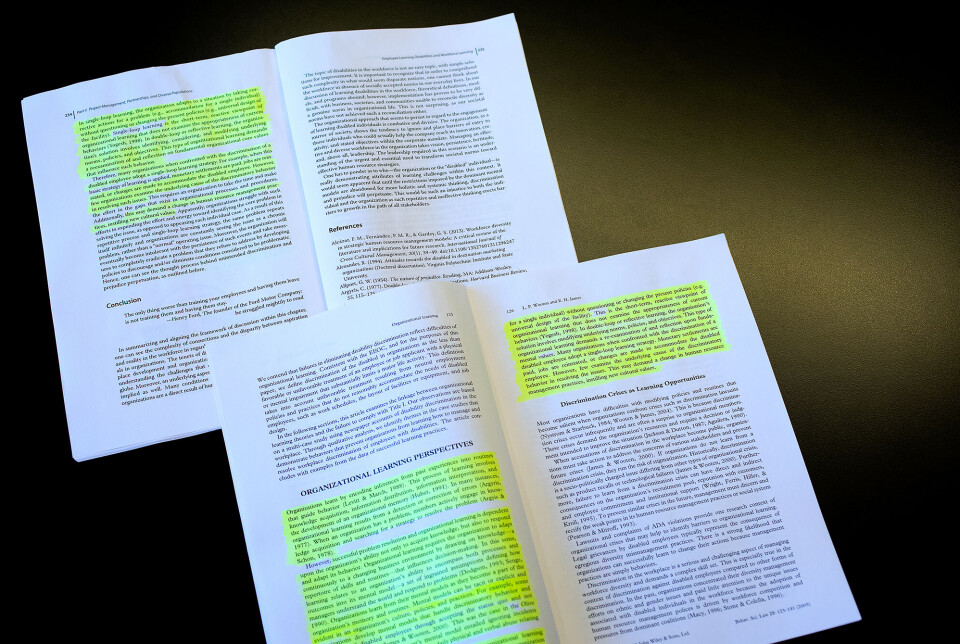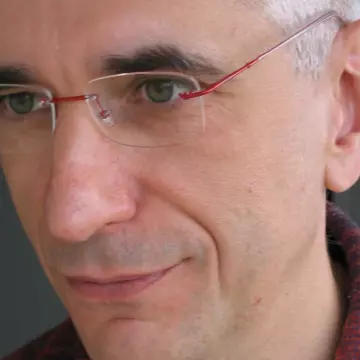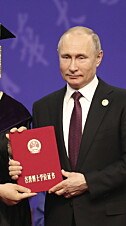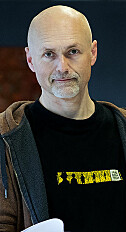Siste fra forsiden:
Kortnytt
Student vant nasjonal inspirasjonspris
Ina Cabanillas Hansen vant prisen Årets unge inspirasjon for sitt engasjement innenfor inkludering, fellesskap og studenters psykiske helse.
Hansen står bak appen Study Buddies, som hun utviklet etter at hun ikke fant noen å skrive oppgaver med som student på Handelshøyskolen BI.
– Dette er det største som har skjedd meg profesjonelt. Personlig betyr det alt. Jeg startet Study Buddies fordi jeg selv slet med å finne min plass som ny student, nå får jeg en nasjonal pris for å ha gjort det lettere for andre. Det er ganske sterkt, sier Hansen i en pressemelding.
Prisen deles ut av Her Awards, som hedrer kvinner som skaper endring. I jurybegrunnelsen står følgende:
«Vinneren har vist et sterkt engasjement for å skape positive endringer for studenter og unge. Med plattformen Study Buddies jobber hun aktivt for å motvirke ensomhet og utenforskap, og hun har blitt en viktig stemme for inkludering og mangfold. Ina har vært åpen om egne erfaringer og brukt sin stemme til å styrke andre – både innen psykisk helse og i debatten om generasjonsforståelse.»

Ina Cabanillas Hansen under prisutdelingen Her Awards. Her Awards Ny forskningsdirektør på OsloMet
Bjørn Tore Kjellemo er ansatt som ny forskningsdirektør ved OsloMet.
— Jeg ser fram til å begynne som forskningsdirektør ved OsloMet, og bli bedre kjent med både universitetet og ikke minst nye kolleger, sier Kjellemo på OsloMet sin nettside.
Kjellemo tiltrer i august. Han kommer fra stillingen som spesialrådgiver i Forskningsrådet, i avdeling for forsknings- og innovasjonssystemet. Tidligere har han vært avdelingsdirektør i Forskningsrådet, det som da het Nærings- og handelsdepartementet, og Kunnskapsdepartementet. Han er utdannet jurist ved Universitetet i Oslo.
— Jeg ser frem til å samarbeide med Bjørn Tore Kjellemo fremover. Han er en erfaren leder med bred kompetanse og innsikt fra arbeid med forskning, utvikling og innovasjon, både nasjonalt og internasjonalt, sier Tanja Storsul, prorektor for forskning og utvikling ved OsloMet.
Kjellemo tar over stillingen etter Yngve Foss, som går av med pensjon. Foss har vært forskningsdirektør ved OsloMet siden 2020.
Ny liste vant studentvalg på UiO
Lista, en ny politisk liste, vant i år studentvalget ved Universitetet i Oslo (UiO).
Lista fikk 18,25 prosent av stemmene.
Oppslutningen i valget var på 11,46 prosent og det var 2923 studenter som avga sin stemme. I fjor var valgoppslutningen på 12,59 prosent, skriver Studentparlamentet i en pressemelding.
– Vi skal fortsette å representere alle studenter – uavhengig av om de stemte eller ikke. Vi gleder oss til et nytt år med nye lister og utvikling av ny og spennende politikk, både lokalt og nasjonalt, sier leder av Studentparlamentet ved Universitetet i Oslo, Sondre Matthias Klungland.
Slik fordelte stemmene seg:
- Lista: 18,25 prosent og 5 mandater.
- Venstrealliansen: 16,87 prosent og 4 mandater.
- Solidaritetslista: 15,23 prosent og 4 mandater.
- Grønn Liste: 12,78 % og 3 mandater.
- A-lista: 11,3 prosent og 3 mandater.
- Liberal Liste: 10,3 prosent og 3 mandater.
- Moderat liste: 8,32 prosent og 2 mandater.
- Universitetslisten: 6,96 prosent og 2 mandater.
Ny leder i Studentinord
Administrerende direktør Kristian Brunsvik Olsen går ut av lederrollen i Studentinord, og Johan Petter Skogseth konstitueres som fungerende administrerende direktør.
– Styret takker Kristian for innsatsen og engasjementet han har lagt ned gjennom en krevende periode, og for hans bidrag til å utvikle Studentinord og styrke det nasjonale samarbeidet mellom samskipnadene, sier fungerende styreleder Kristine Brasøygård Flågan i en pressemelding.
Studentinord er studentsamskipnaden for studenter ved Nord universitet og Politihøgskolens avdeling i Bodø.
Olsen kom inn som administrerende direktør i 2020, og har ledet organisasjonen gjennom mange utfordringer. I pressemeldingen står det at styret og Olsen er enige om at tiden har kommet for et lederskifte i organisasjonen.
– Jeg er stolt av å ha ledet en så flott organisasjon med så engasjerte folk, og av det vi har fått til sammen for studentene. Studentinord går nå over i en ny fase, og etter en god og åpen dialog med styret er vi enige om at det nå er riktig å gi plass til nye krefter, sier Olsen.
Styret starter prosessen med å rekruttere ny administrerende direktør.
Fungerende administrerende direktør Johan Petter Skogseth går inn i et midlertidig lederteam med Geir Abel Jensen for å ivareta den daglige driften.
Norsk forsker vinner internasjonal pris for artikkel
Christian Traeger, økonomiprofessor ved Universitetet i Oslo (UiO), har vunnet prisen Frontiers Planet Prize for en forskningsartikkel.
Prisen deles ut av sveitsiske Frontiers Research Foundation, til forskning som viser potensial til å løse verdens mest alvorlige miljøproblemer.
Artikkelen ble publisert i Science og Traeger er en av 16 forfattere som medvirket til den. Den handler om svakheter i hvordan regjeringer verdsetter natur. UiO skriver om nyheten på sin nettside.
– Tradisjonelt har politikere tatt økosystemer som gir oss ren luft, sunne skoger og biologisk mangfold for gitt. Vi viser at når økosystemene blir knappere fremover og samfunnene samtidig rikere, vil verdien folk tillegger disse naturens goder øke, sier Traeger.
Forskerne foreslår i artikkelen en enkel og praktisk regel for å justere fremtidig verdisetting av naturlige goder, for at offentlig politikk skal stimuleres til å bevare økosystemer.
Traeger er glad for at forskning han har bidratt til, premieres.
– Det får meg til å innse betydningen av å nå ut til publikum med forskningen, slik at den kan anvendes av politikere og myndigheter, sier han.

Christian Traeger er professor ved Økonomisk institutt på Universitetet i Oslo. Svein Harald Milde/ UiO Forskningsrådet lyser ut 452 mill. til bærekraft-sentre
Forskningsrådet lyser ut 452 millioner kroner til forskningssentre for bærekraftig areal- og naturbruk.
‒ For å lykkes med bærekraftig areal- og naturbruk, må vi satse mer på forskning på tvers av sektorer. Disse sentrene skal gi næringslivet og offentlig forvaltning kunnskapen de trenger i dette svært viktige arbeidet, sier Mari Sundli Tveit, administrerende direktør i Forskningsrådet i en pressemelding.
Hvem som blir ansvarlig for sentrene avgjøres i 2026. Finansieringen strekker seg over åtte år, og det forventes at arbeidet fra sentrene bidrar til blant annet utvikling av nye verktøy og metoder, rekruttering, samt kunnskap- og kompetansebygging.
Sentrene skal ledes av en forskningsinstitusjon som et samarbeid mellom offentlig sektor, næringsliv og andre organisasjoner. Arbeidet skal være på tvers av sektorer og fagfelt.
Klima- og miljøminister Andreas Bjelland Eriksen sier vi trenger mer forskning for å løse de komplekse utfordringene som Norge står overfor.
– Disse sentrene skal bidra med kunnskapen og kompetansen vi trenger for å forvalte naturen vår på en bærekraftig måte, og bidra til å nå nasjonale og internasjonale mål, sier Eriksen.
Forskningsrådet legger opp til at det først blir en skisseutlysning og deretter en hovedutlysning. Forskningsorganisasjoner i samarbeid med offentlig sektor, næringsliv og andre samfunnsaktører kan søke.
Ny leder i SAIH
Henriette Reierson Johnstone blir ny leder i SAIH (Studentenes og Akademikernes Internasjonale Hjelpefond).
Hun skal tiltre fra 1. juli 2025 og ble valgt på SAIH sitt årsmøte forrige helg.
– Som leder ønsker jeg å videreføre og styrke SAIH som en kritisk stemme i norsk og internasjonal politikk. Vi står overfor en utfordrende kontekst, med et globalt politisk landskap i endring og autoritære og fascistiske krefter som blir stadig sterkere. Tiden fremover tilsier at vi må være en sterk stemme i kampen mot urett, sier Johnstone i en pressemelding.
De siste to årene har Johnstone vært nestleder i SAIH. Hun tar over ledervervet fra Selma Bratberg.
– Vi står midt i et alvorlig angrep på kunnskap. Utdanning og forskning, studenter og akademikere – selve grunnmuren i samfunnet – er under press. Dette er en tid hvor det blir viktig å styrke beskyttelsesarbeidet av studenter og akademikere som står i frontlinjen for demokratiet, sier Johnstone.

Henriette Reierson Johnstone blir ny leder i SAIH. SAIH Litt mer populært å bli prest
Rekrutteringen til presteyrket har vært laber i flere år, men i fjor opplevde Det teologiske fakultet ved Universitetet i Oslo en sterk oppgang. Da gikk tallet på førsteprioritetssøkere opp fra 25 i 2023 til 44 i fjor.
I år fortsetter oppgangen, skriver Vårt Land. Tall fra Samordna opptak 2025 viser at 47 søkere hadde satt opp profesjonsstudiet i teologi som sitt førstevalg. Det utgjør 2,4 førstevalgssøkere per studieplass.
Ved NLA Høgskolen er pågangen for å utdanne seg til prest ikke den samme. På profesjonsstudiet i Bergen. Der er det bare fem førstevalgssøkere til ti planlagte studieplasser.
-- Profesjonsstudiet har samme søkertall som i fjor, og det er omtrent som forventet. Ser vi på teologi og års- og nettstudier med teologi samlet, har vi en oppgang, sier prorektor Amund Langøy til Khrono.
På bachelor i teologi har NLA i derimot en økning. Det er imidlertid usikkert i hvilken grad dette må tilskrives omlegging av studiene NLA har gjennomført. På dette studiet er det i år 21 søkere til 15 plasser. Med en bachelor kan studentene gå videre til prestestudiet.


















